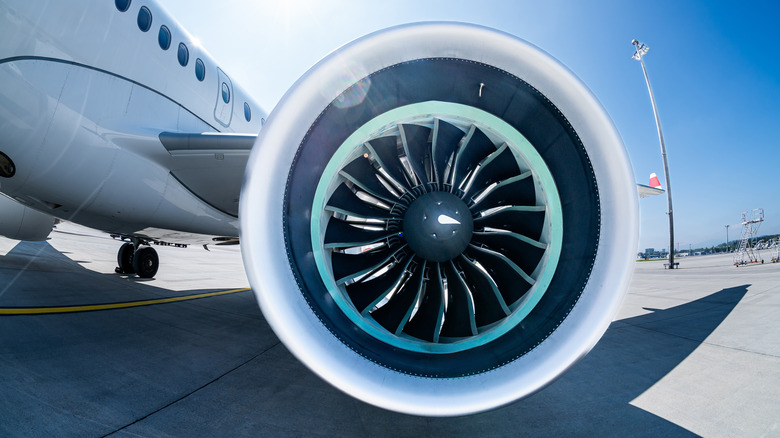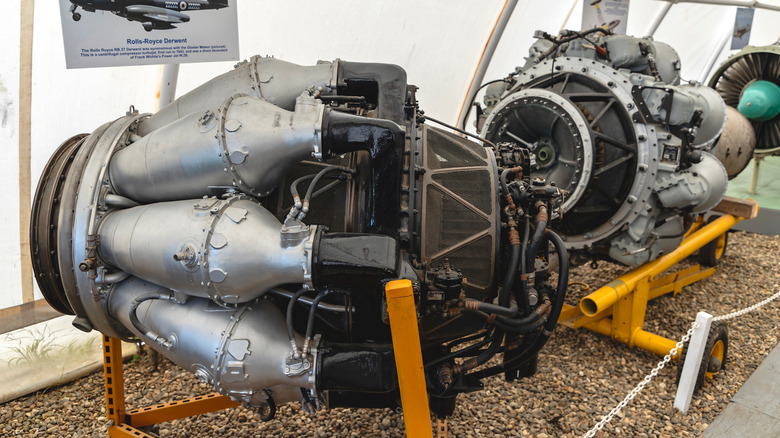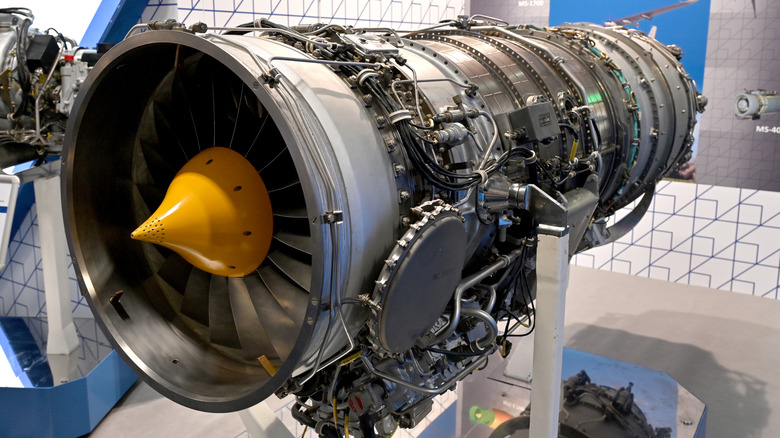Turbojet Vs. Turbofan: What's The Difference Between These Jet Engines?
There are a lot of different aircraft, and they all use a variety of engines from different engine manufacturers. Two of the more commonly used engines are turbofan and turbojet engines. They have a lot of similarities, such as their function of sucking in cool air through the front and pushing that air out the rear to generate thrust, but there are a couple of differences that set these two engines apart. For starters, a turbofan has a fan attached at the front of it, used to send some air to the core of the engine and some around the core. They're also more fuel-efficient than their turbojet counterparts.
As for similarities, both types of engines draw air into a compressor, the beginning of the engine's core, increasing the air's pressure and temperature. From there, it's pushed into the combustion chamber, where the hot air is mixed with jet fuel and ignited. Ignition creates an explosion that generates thrust through one or more turbines and then ejects out of the rear of the exhaust or nozzle, propelling the aircraft forward.
Every aircraft requires a different kind of engine. Some aircraft need to travel at speeds that exceed the speed of sound, like fighter jets in the military. Both types of engines can achieve that, but one is more commonly used for subsonic speeds than the other.
Turbojets revolutionized flight
The first type jet engine was a turbojet that went into production in 1939, finding a home on the German Me 262, making it the first fighter jet to fly during WWII. Militaries the world over started installing turbojets on their combat planes, including the F-4 Phantom II and the MiG-19. It was the Pratt & Whitney J58 turbojet that gave the SR-71 Blackbird such as fast top speed, after all. Turbojets are the engines that changed air travel forever. They're responsible for the first supersonic fighter jet in the world and eventually getting the Concorde passenger plane across the Atlantic in record time.
The earliest turbojets were primarily what is known as a centrifugal design. These had a larger diameter compared to modern turbojet engines and a compressor outlet perpendicular to the axis of rotation of the impeller. Evolution of jet engine design led engineers to axial flow turbojets. Instead of compressing air perpendicular to the axis of rotation, axial turbojets compress the air parallel to the axis of rotation and feature smaller diameters, reducing drag.
Axial flow engines are longer than their predecessor, which made room for more compressor blades, increasing thrust and performance. However, in a side-by-side comparison against turbofans, the turbojet engine isn't nearly as fuel efficient at subsonic speeds. Unlike a turbofan engine, every ounce of thrust turbojets produce is generated by all of the air that enters the engine's intake. As you might imagine, these engines were louder than anything that came before as well as their turbofan successor.
Turbofan engines are more fuel efficient
Unlike turbojet engines, turbofans have a cold section, where some of the air sucked in through the large fan at the front of the engine doesn't go into the compressor. Instead, this air passes through the exterior of the core. While it doesn't ignite in the combustion chamber like the air that flows through the compression chambers, it does generate additional thrust. Air bypassing the engine's core is what earns turbofans the "bypass engine" nickname. Some airlines, such as Boeing, modified some turbojets into turbofans in the '60s to improve fuel economy.
There are two types of turbofan engines. There's the high bypass engine, which receives the bulk of its thrust from the fan and cold section. These are the types you'll find on most commercial airlines. Then there's the low bypass type. These receive the majority of their thrust from the engine's core through combustion. They're more commonly found on military aircraft and can include an afterburner.
It used to be that you would find turbofan engines primarily on commercial aircraft like the 747-8 that the Air Force chose to replace the current Air Force One. The military also used them for many of their transport planes, like the C-17 Globemaster III. However, the turbofan's fuel efficiency is an appealing feature and has been used in modern fighter jets, including the fifth-generation F-22 Raptor and F-35 Lightning II. Turbofans have more components such as the large fan at the front. That fan produces significantly more thrust than other engines by partially compressing the air before it enters the core's compressor.


